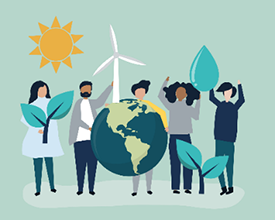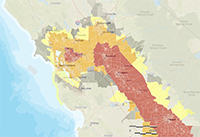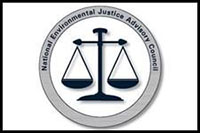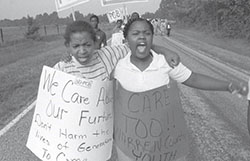May 6: Environmental Justice & Air Quality
BACKGROUND
EPA defines Environmental Justice (EJ) as the fair treatment and meaningful involvement of all people regardless of race, color, national origin, or income, with respect to the development, implementation, and enforcement of environmental laws, regulations, and policies. This goal will be achieved when everyone enjoys:
- The same degree of protection from environmental and health hazards, and
- Equal access to the decision-making process to have a healthy environment in which to live, learn, and work.
 Environmental injustice predominately affects minority, low-income, tribal, and other vulnerable populations. Many of these communities are surrounded by sources of pollution which can cause health and environmental harm.
Environmental injustice predominately affects minority, low-income, tribal, and other vulnerable populations. Many of these communities are surrounded by sources of pollution which can cause health and environmental harm.
Addressing environmental justice is an important part of air quality awareness and work.
WHAT'S HAPPENING?
EPA continues to work toward achieving environmental justice for all by striving to ensure that all people have a healthy environment in which to live, learn, play, and work. EPA is working with all stakeholders to:
- Set limits on pollution to protect health
- Set requirements for permits to limit pollution from factories
- Award grants
- Write and enforce environmental regulations
- Collaborate with other federal agencies to identify and address emerging environmental and public health concerns
https://www.epa.gov/environmentaljustice
OFFICE OF ENVIRONMENTAL JUSTICE
EPA’s Office of Environmental Justice (OEJ) coordinates Agency efforts to address the needs of vulnerable populations by decreasing environmental burdens, increasing environmental benefits, and working collaboratively to build healthy, sustainable communities. OEJ provides financial and technical assistance to communities working constructively and collaboratively to address environmental justice issues. The Office also works with local, state, and federal governments; tribal governments; community organizations; business and industry; and academia, to establish partnerships seeking to achieve protection from environmental and health hazards for all people regardless of race, color, national origin, or income.
Learn more about OEJ’s programs: https://www.epa.gov/environmentaljustice
EJSCREEN
EJSCREEN is an EPA environmental justice mapping and screening tool. Community residents or other stakeholders can use this tool and data as they search for environmental or demographic information. The tool can also support a wide range of research and policy goals. EJSCREEN users can select a geographic area, and the tool will provide demographic and environmental information for that specific area.
To learn more about EJ in your community and across the nation, please visit: https://www.epa.gov/ejscreen/what-ejscreen.
OTHER RESOURCES
White House Environmental Justice Advisory Council
The White House Environmental Justice Advisory Council (WHEJAC) was established by President Biden’s Executive Order on Tackling the Climate Crisis at Home and Abroad to fulfill his administration’s commitment to confronting longstanding environmental injustices and to ensuring that historically marginalized and polluted, overburdened communities have greater input in federal policies and decisions.
https://www.epa.gov/environmentaljustice/white-house-environmental-justice-advisory-council
National Environmental Justice Advisory Council
The National Environmental Justice Advisory Council (NEJAC) is a federal advisory committee that reports to EPA and provides advice and recommendations about broad, cross-cutting issues related to environmental justice, from all stakeholders involved in the environmental justice dialogue. In addition, the NEJAC provides a valuable forum for discussions about integrating environmental justice with other EPA priorities and initiatives.
https://www.epa.gov/environmentaljustice/national-environmental-justice-advisory-council
Resources for Creating Healthy, Sustainable, and Equitable Communities
Creating healthy, sustainable, and equitable communities is a priority of the federal government. Environmental justice plays a key role in an integrated effort that simultaneously addresses housing, environment, transportation, and health issues. Learn more about federal resources, technical assistance, and funding opportunities that address this integrated approach to environmental justice.
Environmental Justice for Tribes and Indigenous Peoples
EPA’s tribal program and environmental justice programs focus on helping federally recognized tribes develop their own environmental programs and on working with other indigenous groups to protect environment and public health in Indian country.
https://www.epa.gov/environmentaljustice/environmental-justice-tribes-and-indigenous-peoples






